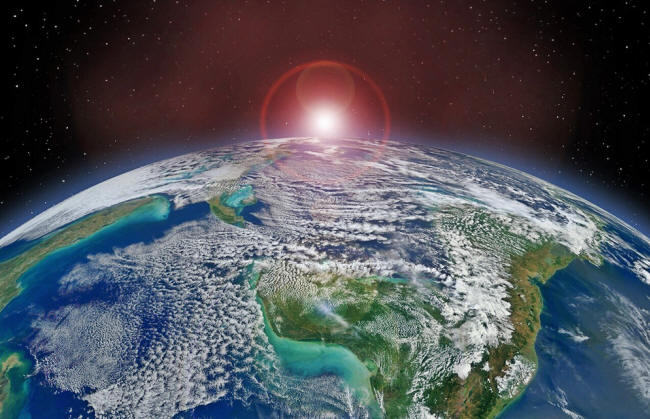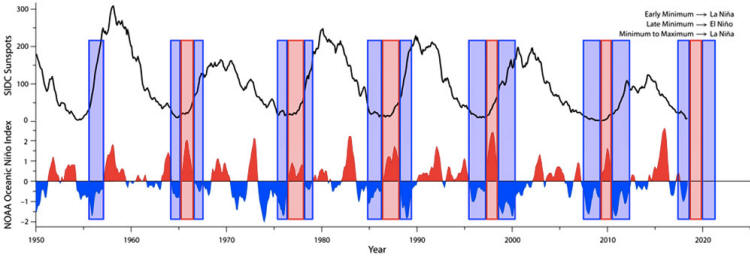|

by David Whitehouse
April 06,
2021
from
TheGlobalWarmingPolicyForum Website

"The scientific
community
has been unclear
on the role that solar variability
plays in
influencing weather and climate events
here on Earth.
This study shows
there's reason to believe
it absolutely
does and why the connection
may have been
missed in the past."
If you ask most climate scientists, they will tell you that the
Sun's small variability is unimportant when it comes to influencing
climate.
They may have to
change their minds if a
new line of research holds up.
It seems that solar
variability can drive climate variability on Earth on decadal
timescales (the decadal climatic variability that Michael Mann
recently 'proved'
doesn't exist).
That's the
conclusion of a new study showing a correlation between the end of
solar cycles and a switch from
El Niño to
La Niña conditions in the
Pacific Ocean.

Top: Six-month smoothed monthly sunspot number from SILSO.
Bottom: Oceanic El Niño Index from NOAA.
Red and blue boxes mark the El Niño and La Niña periods
in the repeating pattern.
Source: Climate Etc,
September 2019
It's a result that could significantly improve the predictability of
the largest El Niño and La Niña events, which have several global
climate effects.
"Energy from the Sun
is the major driver of our entire Earth system and makes life on
Earth possible," said Scott McIntosh, of the National Center for
Atmospheric Research, a co-author of the paper.
"Even so, the
scientific community has been unclear on the role that solar
variability plays in influencing weather and climate events here
on Earth.
This study shows
there's reason to believe it absolutely does and why the
connection may have been missed in the past."
The approximately 11-year
solar cycle - the appearance (and disappearance) of spots on the Sun
- has been known for hundreds of years.
In this new study, the researchers use a 22-year "clock" for solar
activity derived from the Sun's magnetic polarity cycle, which they
consider a more regular alternative to the 11-year solar cycle.
This research (Quantifying
the Solar Cycle Modulation of Extreme Space Weather) was published last year.
'Coincidence
unlikely'
Applying this to climate studies the researchers found that the five
estimates of the end of a solar cycle that occurred between 1960 and
2010-11 all coincided with a flip from an El Niño (when sea surface
temperatures are warmer than average) to a La Niña (when the sea
surface temperatures are cooler than average).
The end of the most recent solar cycle - happening now - is also
coincident with the beginning of a La Niña event.
Robert Leamon of
the University of Maryland/Baltimore County said,
"Five consecutive
terminators lining up with a switch in the El Niño oscillation
is not likely to be a coincidence."
In fact, only a 1 in
5,000 chance or less (depending on the statistical test) that all
five terminator events included in the study would randomly coincide
with the flip in ocean temperatures.
Now that a sixth terminator event - and the corresponding start of a
new solar cycle in 2020 - has also coincided with a La Niña event,
the chance of a random occurrence is even more remote.
The paper does not delve into what physical connection between the
Sun and Earth could be responsible for the correlation, but the
authors note that there are several possibilities that warrant
further study, including the influence of the Sun's magnetic field
on the number of
cosmic rays that escape into the solar system and
ultimately bombard Earth.
However, a robust physical link between cosmic ray variations and
climate has yet to be determined.
"If further research
can establish that there is a physical connection and that
changes on the Sun are truly causing variability in the oceans,
then we may be able to improve our ability to predict El Niño
and La Niña events," McIntosh said.
| 


